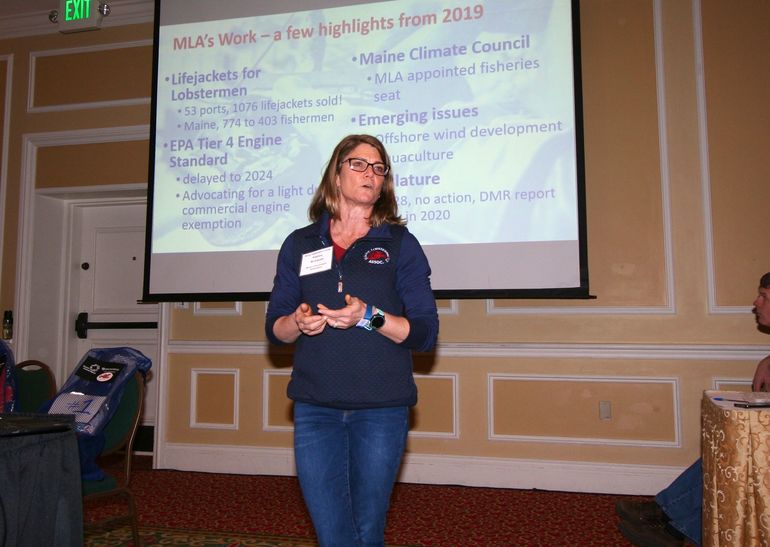Lobster landings dropped last year but the price rose
 Photo / Laurie Schreiber
Speaking at the Maine Lobstermen’s Association’s annual meeting March 6, Executive Director Patrice McCarron said saving right whales must be a shared responsibility by all who have a potential to harm them.
Photo / Laurie Schreiber
Speaking at the Maine Lobstermen’s Association’s annual meeting March 6, Executive Director Patrice McCarron said saving right whales must be a shared responsibility by all who have a potential to harm them.
Maine’s lobster landings showed a 17% decline in 2019, compared with 2018, but landings still topped the 100-million-pound mark and the value of the harvest looked good.
The overall value of the catch, $485 million, was down from $491.6 million in 2018. Despite the reduced catch, lobster fetched more on the wholesale market last year, $4.85 versus $4.05 in 2018.
Last year ranked as the fourth-most lucrative for the fishery on the strength of a 20% increase in per-pound value.
Meanwhile, the Maine Lobstermen’s Association continues to fight with federal regulators about impending regulations around the endangered North Atlantic right whale.
“A lot of people said, ‘I think I can survive this round, but what comes next? I can’t even think about it,’” the association’s executive director, Patrice McCarron, said of a survey the association sent to its members to get input about the proposed regulations. “And I think that’s the fear we live with every day.”
Late fishing season
According to the Department of Marine Resources, lobster harvesters landed 100.7 million pounds, marking the ninth year in a row of landings that topped 100 million pounds.
The lobster industry had a slow start in 2019, but ended strong, with landings picking up significantly in the last few months, DMR Commissioner Patrick Keliher said in a press release.
Keliher said many factors in the marine environment impact landings. In 2019, the cold spring caused a delay in the molt, which is when lobsters shed their shells and the bulk of the harvest occurs. Fishermen held off until the shed happened.
According to data published by the National Oceanic and Atmospheric Administration, American lobster was the most valuable single species harvested in the U.S. in 2015-18, with Maine landings accounting for approximately 80% of that value each year.
Right whales
The Maine Lobstermen’s Association has been engaged in the management, science, regulatory, policy and legal process to ensure the lobster industry has a voice in new federal regulations expected to impact the fishery, McCarron said during the association’s annual meeting March 6, held at the Maine Fishermen’s Forum in Rockport.
“We believe management needs to be based on sound science and use the best available data,” she said. “We believe saving right whales must be a shared responsibility by all who have a potential to harm them. Maine will do its part, but the lobster fishery alone can’t solve this problem. Ten whales died in Canada last year. We couldn’t have solved that.”
The association has rejected a federal plan to reduce the risk of entanglement by North Atlantic right whales in lobster fishing gear by 60%. The strategy includes removing half the number of lobster trap endlines in the water and using weak rope in the top of remaining endlines, which are the vertical lines that connect lobster traps on the ocean bottom with a buoy at the sea surface. The association also rejected the state's modified plan that hinges on an existing nearshore exemption area.
The association studied data on injuries and deaths and found that other types of fishing gear, other regions and ship strikes are part of the problem, McCarron said. In cases where the cause of death was unknown, the federal government “wants to call all of the unknown ‘lobster,’ because we’re the biggest fishery,” she said. “We reject that.”
She added, “We know our gear interacts with whales and does cause harm.” But most whale deaths in the Gulf of Maine occurred before the existing suite of protective regulations was implemented, she said.
The association is an intervener in a court case filed by four environmental groups in federal court in Washington, D.C., which argues that the government has violated U.S. law by allowing lobster fishing to continue. Providing pro bono monitoring of the case is Mary Anne Mason, a retired partner at Washington, D.C., law firm Crowell & Moring LLP.
“There’s strong potential that a judge will be deciding how you fish, period,” said McCarron. “The question is, How do we come out intact? Probably something different than we have now or that we want. But how do we come out with something to build and sustain a future for our fishery?”
Overall fisheries
At $673.9 million, the value of Maine's commercially harvested marine resources in 2019 was the second highest of all time, and an increase of more than $26 million over 2018.
• Elvers again topped $2,000 per pound which resulted in an overall value of $20.1 million, ranking it as the second most valuable species harvested in Maine in 2019 and once again by far the most valuable on a per pound basis.
• Softshell clammers raked in an additional 623,000 pounds compared to 2018, which generated more than $18 million for harvesters and made softshell clams Maine’s third most valuable species. The uptick in value was due to the additional landings plus a 30% increase in value, which jumped from $1.80 per pound in 2018 to $2.34 per pound in 2019.
• 3.2 million pounds of oysters were harvested in 2019, an increase of 460,911 pounds over 2018, resulting in a jump in value of $336,334, for a total value of $7.6 million, making oysters the fourth most valuable species.
• The fifth and sixth most valuable fisheries in Maine were blood worms, used as bait for species including striped bass, valued at $6.3 million, and urchins, worth $5.8 million.










0 Comments